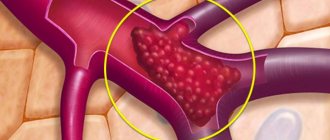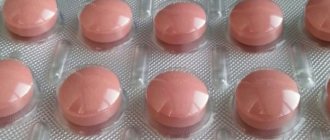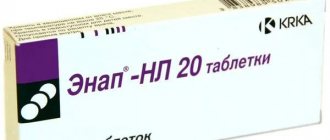Compound
According to the INN, all dosage forms of the drug Curantil include the active ingredient dipyridamole in different mass parts.
- 1 tablet of Curantyl 25 contains 25 mg of dipyridamole . Additionally: macrogol 6000, lactose monohydrate, polyvidone K25, corn starch, titanium dioxide, gelatin, carnauba wax, magnesium stearate, glucose syrup, talc, calcium carbonate, sucrose, light basic magnesium carbonate, quinoline yellow dye.
- 1 tablet of Curantil N 25 includes 25 mg of dipyridamole . Additionally (including shell): highly dispersed silicon dioxide, lactose monohydrate, macrogol 6000, sodium carboxymethyl starch (type A), talc, titanium dioxide, corn starch, hypromellose, gelatin, simethicone emulsion, magnesium stearate, quinoline yellow dye.
- 1 tablet of Curantil N 75 includes 75 mg of dipyridamole . Additionally (including shell): highly dispersed silicon dioxide, lactose monohydrate, macrogol 6000, sodium carboxymethyl starch (type A), talc, titanium dioxide, corn starch, hypromellose, gelatin, simethicone emulsion, magnesium stearate, quinoline yellow dye.
Pharmacodynamics and pharmacokinetics
The abstract for the drug positions Curantil as a vasodilating therapeutic agent with myotropic action, which has an inhibitory effect on platelet aggregation, improves microcirculation, and is also characterized by mild vasodilatory effectiveness.
The vasodilator effect of small doses of dipyridamole is selectively aimed at expanding the arterioles of the coronary circulation and, unlike calcium antagonists and organic nitrates, does not affect the larger vessels of this system. Taking high doses of dipyridamole leads to dilation of arterioles in other areas of the systemic blood flow, for which this medicine is used for the treatment and prevention of vascular pathologies of various types.
The vasodilator effectiveness of the drug is manifested due to two different mechanisms of its action, which consist in inhibiting the process of adenosine and suppressing the production of phosphodiesterase .
Due to the dynamic equilibrium observed between the release of adenosine and its reuptake, the intracellular content of this nucleoside is at the level of 0.15-0.20 µmol. When taking small doses of dipyridamole, inhibition of adenosine uptake by platelets , erythrocytes and endothelial cells is noted, which leads to an increase in its plasma concentration and increased adenosine-dependent vasodilation. High dosages of the drug inhibit platelet aggregation caused by the action of adenosine, thereby reducing the risk of thrombosis.
In turn, large doses of dipyridamole inhibit phosphodiesterases , which are responsible for the breakdown of cAMP and cGMP - effectors that influence the suppression of platelet aggregation. cGMP phosphodiesterase is suppressed . of cAMP synthesis increases .
Another feature of the effectiveness of dipyridamole, as a pyrimidine , is its ability to induce the production of interferon . In vitro, the drug has a modulating effect on the functionality of the interferon system and increases the initially reduced synthesis of alpha and gamma interferon by plasma leukocytes , thus increasing the nonspecific resistance of the human body to viral infections.
When administered orally with dipyridamole at a dose of 150 mg, the plasma TCmax of 2.66 μg/L is approximately 60 minutes. Binding to plasma proteins is almost complete. The greatest accumulation of the drug is observed in erythrocytes and the heart.
Metabolic transformations occur in the liver, for which the mechanism of binding dipyridamole with glucuronic acid . The average T1/2 is 20-30 minutes. In the form of a monoglucuronide, the drug is excreted in the bile.
Curantyl® N 25 (Curantyl® N 25)
Dipyridamole inhibits platelet aggregation and adhesion, improves microcirculation, and has a mild vasodilator effect. The mechanism by which dipyridamole has an inhibitory effect on platelet aggregation is associated with the suppression of the reuptake of adenosine (an inhibitor of platelet reactivity) by endothelial cells, erythrocytes and platelets; activation of adenylate cyclase and inhibition of platelet phosphodiesterases. Thus, dipyridamole prevents the release of aggregation activators from platelets - thromboxane (TxA2), ADP, serotonin, etc. Dipyridamole increases the synthesis of prostacyclin PgI2 by the endothelium of the vascular wall, normalizes the ratio of PgI2 and TxA2, preventing platelet aggregation; enhances the synthesis of endothelial nitric oxide (NO). Dipyridamole reduces platelet adhesiveness, prevents the formation of blood clots in blood vessels and stabilizes blood flow in the ischemic area.
Dipyridamole dose-dependently prolongs the pathologically shortened platelet life time.
Dipyridamole, due to its vasodilating properties, helps reduce total peripheral vascular resistance, improves microcirculation, and has an angioprotective effect. These effects are due to increased activity of endogenous adenosine (adenosine affects vascular smooth muscle and prevents the release of norepinephrine). Dipyridamole has both angiogenic and arteriogenic activity, stimulating the formation of new capillaries and collateral arteries.
Dipyridamole normalizes venous outflow and reduces the incidence of deep vein thrombosis in the postoperative period. Improves microcirculation in the retina and renal glomeruli.
In neurological practice, the pharmacodynamic effects of dipyridamole are used, such as reducing cerebral vascular tone and improving cerebral circulation. According to angiographic studies, the use of dipyridamole in combination with acetylsalicylic acid (ASA) can slow down the progression of atherosclerosis.
In obstetric practice, dipyridamole is used to improve placental blood flow and prevent dystrophic changes in the placenta, eliminate hypoxia of fetal tissue and the accumulation of glycogen in them. Thus, it is advisable to use dipyridamole for early manifestations of placental insufficiency, in pregnant women with a high risk of placental insufficiency: intrauterine infection, gestosis (threat of preeclampsia and eclampsia), autoimmune pathology, extragenital diseases (diabetes mellitus, metabolic syndrome); as well as diseases with a tendency to thrombosis.
As a pyrimidine derivative, dipyridamole is an interferon inducer and has a modulating effect on the functional activity of the interferon system, in
vitro
increases the reduced production of interferon alpha (α) and gamma (γ) by blood leukocytes. Increases nonspecific antiviral resistance to viral infections.
Indications for use
The main indications for use of Curantil include:
- treatment of dyscirculatory encephalopathy ;
- prevention and treatment of cerebral circulatory disorders of the ischemic type;
- treatment of any microcirculation disorders (in combination with other drugs corresponding to the pathology);
- prevention of coronary artery disease (primary and secondary), especially in case of personal intolerance to acetylsalicylic acid ;
- prevention of possible thromboembolism in the postoperative period of heart valve replacement ;
- prevention of the formation of venous and arterial thrombosis , as well as treatment of complications of thrombosis;
- prevention and treatment of acute respiratory viral infections and influenza (for a dosage of 25 mg), as an immunomodulator and interferon inducer.
Indications for use of Curantil during pregnancy include:
- prevention of placental ( fetoplacental ) insufficiency , fetal malnutrition and gestosis that occur during complicated pregnancy ;
- prevention of hypercoagulation and thrombus formation in the presence of varicose veins .
Indications for use of the drug Curantil
Stable angina, chronic heart failure, prevention and treatment of myocardial infarction, prevention and treatment of ischemic cerebral circulatory disorders, chronic cerebral circulatory failure, discirculatory encephalopathy, vascular insufficiency, prevention of the formation of arterial and venous blood clots and thromboembolic complications (in combination with acetylsalicylic acid or with anticoagulants), prevention of thromboembolism after heart valve replacement, prevention of placental insufficiency, intermittent claudication, as part of complex therapy for microcirculation disorders of various origins.
Contraindications
Contraindications to the use of Curantil are:
- unstable angina;
- myocardial infarction in the acute period;
- coronary arterial disease ( stenotic atherosclerosis );
- collapse;
- heart failure in the decompensation stage;
- subaortic stenosis;
- arterial hypotension;
- severe heart rhythm disorders;
- complicated arterial hypertension ;
- obstructive pathologies of the bronchopulmonary system of a chronic course;
- serious / kidney pathologies ;
- hemorrhagic diathesis;
- age up to 12 years;
- painful conditions that occur with an increased likelihood of bleeding;
- personal hypersensitivity to dipyridamole or other components of the drug.
Special instructions for the use of the drug Curantil
In case of lactase deficiency, galactosemia and glucose/galactose malabsorption, the drug should not be used. Use during pregnancy and lactation. The use of Curantil is possible only after assessing the possible risks and expected benefits. Use in children. The use of dipyridamole in children under 12 years of age is not recommended because there is insufficient clinical experience. The ability to influence reaction speed when driving vehicles or operating machinery. Blood pressure may decrease, and the resulting lack of blood supply to the brain may affect the ability to drive vehicles and operate potentially dangerous machinery.
Side effects
The use of therapeutic dosages of Curantil rarely leads to the formation of negative phenomena, and even if they occur, the side effects of the drug are most often mild and transient.
The cardiovascular system:
- cardiopalmus;
- feeling of “hot flashes” on the skin of the face;
- tachycardia (especially when taking other vasodilating drugs in parallel);
- bradycardia;
- steal syndrome in relation to the coronary vessels (when taking daily doses of dipyridamole exceeding 225 mg);
- decrease in blood pressure.
Hemostasis system:
- functional changes in platelets;
- thrombocytopenia;
- development of bleeding;
- increased bleeding during or after surgical procedures (very rare).
Digestive system:
- epigastric pain;
- nausea , vomiting ;
- development of diarrhea .
With long-term therapy, gastrointestinal side effects usually disappear on their own.
Other:
- feeling of noise or fullness in the ears;
- dizziness;
- general weakness;
- facial hyperemia;
- headache;
- arthritis;
- rhinitis;
- myalgia;
- allergic manifestations ( rash / urticaria ).
Pharmacological properties of the drug Curantil
Pharmacodynamics. Curantil is an antiplatelet agent that inhibits the reverse penetration of adenosine into the intracellular space, thereby increasing its concentration in the blood plasma and the antiplatelet effect on platelets and erythrocytes. In addition, Curantil increases the antiplatelet activity of prostaglandin E1 and in high doses inhibits PDE in platelets, as a result of which cAMP accumulates in them and the release of thromboxane A2 from them is inhibited, which leads to inhibition of platelet aggregation and an increase in their life expectancy. Thanks to the adenosine mechanism, the drug also dilates the coronary arteries, increases coronary blood flow and stimulates the formation of collaterals. Pharmacokinetics. After oral administration, it is quickly absorbed into the gastrointestinal tract, mainly in the stomach and partially in the small intestine. Absorption largely depends on the pH level of gastric juice, so bioavailability has significant individual variations and amounts to 43±13%. About 98% binds to blood plasma proteins and accumulates in the heart and red blood cells. Cmax in blood plasma is observed approximately 60 minutes after oral administration. Dipyridamole is metabolized in the liver by binding to glucuronic acid. T1/2 is 20–30 minutes. The drug is excreted mainly in bile and feces in the form of monoclucuronide.
Curantil tablets, instructions for use
Instructions for use Curantyl 25
For the prophylactic purpose of ARVI and during influenza , a single daily dose of 50 mg of Curantyl 25 (2 pills or tablets) is usually prescribed, once every 7 days for 4-5 weeks (4-5 doses per course).
To prevent possible relapses of ARVI , especially for patients who often suffer from these infections, a daily dose of 100 mg (4 pills or tablets) in two stages (2 pills or tablets (50 mg)) with an interval of 120 minutes is indicated. The prophylactic course lasts 8-10 weeks with a single dose of the recommended dose of the drug every 7 days.
Instructions for use Curantyl 75
The daily dosage of Curantyl N 75 is selected taking into account the severity of the disease and the patient’s personal response to the treatment.
For the treatment of coronary heart disease , as a rule, a three-time dose of 75 mg of the drug per day is recommended (1 tablet every 8 hours). Based on the observed effectiveness, the physician may increase the daily dose.
To prevent thrombosis and for cerebral circulatory disorders, 3-6 tablets of Curantyl 75 mg are usually prescribed per day. In 24 hours, you can take a maximum of 450 mg of the drug.
In order to reduce platelet aggregation, Curantil is used in the daily dose range of 75-225 mg (1-3 tablets) in several doses. The maximum possible daily dosage of dipyridamole in severe cases is 600 mg.
Instructions for use of Curantil during pregnancy
When using Curantil during pregnancy , the selection of its dosage is carried out purely individually. A typical treatment regimen is to take 25 mg of the drug (1 pill or tablet) three times every 24 hours.
How to take - before or after meals?
For all of the above indications, Curantyl dragees and tablets are recommended to be taken on an empty stomach, without crushing or chewing the dosage forms, and with 100-150 ml of water.
Use of the drug Curantil
Therapy should begin with a gradual increase in dose. The duration of treatment and dose are set individually depending on the indications and tolerability. Curantil can be used for a long course of treatment. Dragees are taken without chewing, with liquid, on an empty stomach or 1 hour before meals. Adults and children over 12 years of age: 75–225 mg of dipyridamole per day (3–9 tablets) in several divided doses. If the disease is mild or if the condition improves, you can take 25–50 mg 3 times a day. In severe cases of the disease, the dose can be increased to 600 mg of dipyridamole per day. To prevent thromboembolism in patients simultaneously using anticoagulants or acetylsalicylic acid, the drug is prescribed 75 mg 3-6 times a day.
Overdose
In cases of dipyridamole overdose the following was observed:
- the occurrence of angina and/or tachycardia ;
- decreased blood pressure;
- general weakness;
- feeling of "hot flashes";
- dizziness.
If symptoms of overdose are quickly detected, typical countermeasures will be effective, including inducing vomiting, cleaning the gastrointestinal tract, and taking sorbents. To stop the dilating effect of the drug, slow intravenous administration (50-100 mg/min) of Aminophylline . angina pectoris persist, sublingual administration of Nitroglycerin .
Side effects of the drug Curantil
Usually mild and transient: from the cardiovascular system: headache and dizziness of vascular origin, arterial hypotension, skin flushing with a feeling of heat, tachycardia, especially when using vasodilators, sometimes - exacerbation of coronary heart disease; with abrupt withdrawal of the drug, unstable angina or heart attack may develop myocardium; from the gastrointestinal tract: nausea, vomiting, diarrhea, dyspeptic disorders; from the hepatobiliary system: there are reports that dipyridamole is part of gallstones; from the skin and subcutaneous tissue: skin rash and urticaria; from the immune system: bronchospasm and Quincke's edema are possible; from the blood and lymphatic system: very rarely - increased bleeding during or after surgery, in some cases - thrombocytopenia. from the musculoskeletal system: myalgia; general disorders: general weakness.
Interaction
Xanthine derivatives (including tea and coffee) may reduce the vasodilatory effectiveness of dipyridamole.
Antacids, due to decreased absorption of the drug, lower its maximum concentrations.
Parallel use with Aspirin and anticoagulants (thrombolytics, Heparin ) increases the possibility of bleeding.
Dipyridamole potentiates the effectiveness of antihypertensive drugs.
When combined with cholinesterase inhibitors, a decrease in their anticholinergic properties is observed.
Combined use with cephalosporin antibiotics ( Cefoperazone , Cefamandole , Cefotetan ) can lead to increased antiplatelet effects.
Interactions of the drug Curantil
Xanthine derivatives (caffeine, theophylline) can weaken or completely neutralize the effect of the drug, so they should not be prescribed simultaneously. During treatment with Curantil, you should refrain from frequent drinking of strong coffee or tea. Under the influence of the drug, the effect of antihypertensive drugs may increase, and the anticholinergic activity of distigmine may decrease. Curantil may enhance the effect of anticoagulants and acetylsalicylic acid, therefore, when using them simultaneously, it is necessary to take into account the possible increase in the risk of intolerance to these drugs.
Analogs
Level 4 ATC code matches:
Persantine
Aegitromb
Plavix
Coplavix
Cardiomagnyl
Polocard
Thrombo ACC
Brilinta
Magnicor
Plagril
Dipyridamole
Clopidogrel
Lopirel
Sylt
CardiASK
Aspirin Cardio
Acecardole
Aspinat
Aspicor
Curantil analogues are represented by a fairly wide list of drugs similar to it in their main anticoagulant and antiplatelet effects. The most famous analogues are:
- Aspirin Cardio
- Aspicor
- Aspecard
- Sylt
- Atherocardium
- Godasal
- Atrogrel
- Cardiomagnyl
- Brilinta
- Clopidogrel
- Disgren
- Plagril
- Magnicor
- Plavix
- Trombonet
The price of Curantil analogues depends on the manufacturer, the number of tablets and the mass content of the active ingredient in them and therefore varies within fairly wide limits. For example, Aspirin Cardio 100 mg No. 20 can be purchased on average for 130 rubles, Clopidogrel 75 mg No. 28 for 500 rubles, and Plavix 75 mg No. 28 for 2,600 rubles.
Overdose of the drug Curantil, symptoms and treatment
Symptoms: general vasodilation, accompanied by hypotension, tachycardia, a feeling of warmth in the body, flushing of the facial skin, weakness and dizziness. Treatment: it is necessary to rinse the stomach or induce vomiting; carry out measures to reduce absorption, prescribe adsorbents and other symptomatic therapy. The vasodilating effect of dipyridamole can be stopped by intravenous administration of aminophylline (50–100 mg over 1 min). Sublingual nitroglycerin is used to relieve an attack of angina.
Chimes during pregnancy and lactation
The practice of prescribing Curantil during pregnancy exists mainly in the post-Soviet countries, where gynecologists have been using the positive properties of this drug for quite a long time and quite successfully.
Sometimes this drug is prescribed even when planning pregnancy , if a woman who wants to become pregnant experiences various painful conditions associated with impaired blood circulation, microcirculation, or an increased tendency to form blood clots. The daily dosage of such pathologies, according to the instructions for use, is selected individually and can reach 450 mg, so it would be advisable to use Curantil N 75. Another advantage of such preventive therapy, of course, is the ability of dipyridamole to increase the body's resistance to various infections by stimulating the production of interferon .
During pregnancy itself, the prescription of any medications must be approached strictly individually and with extreme caution, and therefore, before taking Curantil during pregnancy, it is necessary to completely eliminate contraindications and possible risks of therapy for both the expectant mother and the fetus. When to start treatment, at what stage to carry out therapy and for how long to take the drug, the gynecologist should determine it, in accordance with the patient’s medical history and her current condition.
In cases where the expectant mother has pathologies associated with blood circulation or thrombus formation, which could potentially lead to pregnancy complications in the future, drug treatment may be simply necessary, for which Curantil is prescribed to pregnant women in the early stages. In this case, the dosage of the drug can be quite significant, which increases the risk of bleeding and requires special attention from medical personnel.
In the later stages of pregnancy, the development of negative phenomena is often noted, arising, among other things, due to insufficient microcirculation (including swelling , toxicosis , headaches , increased blood pressure, convulsions, etc.). Solving such problems is also among the indications for the use of Curantil, for which it is prescribed to pregnant women most often in minimal doses (25 mg 2-3 times every 24 hours) and, depending on the severity of the observed negative symptoms, in courses of varying duration. In some cases, such treatment continues throughout pregnancy with short breaks and stops immediately before birth.
In the second trimester of pregnancy placental insufficiency - a complication characterized by impaired blood supply to the placenta and can lead to fetal hypoxia, delayed development, and sometimes spontaneous abortion . Therapeutic courses with the prescription of Curantil N 25 (1 tablet 2-3 times a day) in most cases prevent the development of this complication or significantly reduce its manifestations, without having any effect on the fetus.
Indications for the use of Curantil during pregnancy in the 3rd trimester are placental insufficiency and gestosis ( late toxicosis ), in which the drug, by improving blood supply to the placenta, helps the final full formation of the brain, lungs and other organs of the unborn child, and also significantly reduces the negative impact of these complications on its mother. Sometimes, in severe cases of gestosis and/or placental insufficiency, the effects of one drug may not be enough, for which purpose complex therapy using several drugs is prescribed during pregnancy, for example, Actovegin and Curantil. The improvement in tissue trophism and regeneration, as well as metabolism, inherent in Actovegin , perfectly complements the vasodilating effects of Curantil, thereby protecting the female body from many negative painful manifestations, including the threat of miscarriage .
It is important to remember that at any time you can demand from your doctor comprehensive explanations to questions about why this or that drug is prescribed to pregnant women, how to drink or administer the prescribed dosage form, what dosages to follow, what positive aspects, and most importantly, negative consequences this treatment can lead to. treatment and why it is prescribed to you. In this regard, you should not rely on reviews about Curantil during pregnancy left on various Internet resources, since there is no guarantee that your situation is similar to those described by other women. It is also necessary to thoroughly find out all the possible side effects of the drug and methods of preventing their occurrence, scrupulously monitor your well-being and undergo regular examinations on time.
The possibility of using Curantil during breastfeeding is determined by the doctor.
Reviews about Kurantil
Due to the fairly frequent prescription of this drug to pregnant women, the prevailing number of reviews about Curantyl N 25 on forums are left by mothers who have ever taken it, while reviews about Curantyl during pregnancy in most cases can be divided into positive and neutral.
Although some side effects of the drug are occasionally mentioned, including flushing , palpitations and headaches, purely negative assessments, except in cases of personal hypersensitivity to the ingredients of the drug, are practically never found. Conversely, there are enough positive reviews of the effectiveness of Curantil to at least consider the issue of its use. Naturally, the prescription of Curantil should be clearly reasoned and thought out, and its dosage and number of doses should be reduced to the required minimum.
Also, many women, having heard about the prescription of this drug, try to find explanations for themselves about the expediency and safety of its use, using the Internet, whereas the correct thing to do would be to clarify this issue with their attending physician, who is simply obliged to provide all the information that interests you.
Curantila price, where to buy
The average cost of all dosage forms of this drug can sometimes vary depending on the region and pharmacy chain, but generally it is approximately at the same level. For example, you can buy 100 tablets of Curantil 25 in Moscow for about the same price as 25 mg of the same drug No. 100 costs in St. Petersburg.
- The price of Curantil 25 (100 tablets of 25 mg), most often prescribed as an immunomodulator, is about 900 rubles.
- The cost of Curantil N 25 No. 120 tablets, traditionally used during pregnancy, varies between 800 rubles.
- The price of Curantil N 75 No. 40 tablets, usually used for the prevention and treatment of pathologies of the circulatory system, fluctuates around 1,700 rubles.
- Online pharmacies in RussiaRussia
- Online pharmacies in KazakhstanKazakhstan
ZdravCity
- Curantil tablets p.p.o.
25 mg 120 pcs. JSC "Berlin-Pharma" 817 rub. order - Curantil N 75 tablets p.p.o. 75 mg 40 pcs. JSC "Berlin-Pharma"
932 rub. order
Pharmacy Dialogue
- Curantil N 25 (tablet p/o 25 mg No. 120)Berlin-Chemie AG/Menarini
RUR 767 order
- Curantil N75 tablets 75 mg No. 40Berlin-Chemie AG/Menarini
RUB 1,746 order
show more







